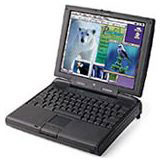Ever since the return of Steve Jobs, Apple has vastly simplified
both its product line and its product names. This, of course, makes
things more complicated. Witness four generations of G3 PowerBooks all
bearing strikingly similar names.
- In November 1997 came the PowerBook G3, a 250 MHz model with a
12" 800 x 600 display. This was the fastest laptop computer in the
world. This model was based on the earlier PowerBook 3400 and is sometimes known
by the code names 3400 and Kanga.
- In May 1998, Kanga gave way to the PowerBook G3 Series, a family
of models available at three CPU speeds (233, 250, and 292 MHz) and
display sizes (12", 13", and 14"). The code name for this series was
WallStreet. The entry-level model lacked a level 2 cache, earning it
the Road Apple title and the
MainStreet nickname. The 13" display was also problematic.
- In August 1998, Apple updated the PowerBook G3 Series to what some
of us call Series
II. Also commonly known as WallStreet, these normally had a 14"
display. CPU speeds were 233, 266, and 300 MHz, and this time the
entry-level model had a level 2 cache. There was also a limited edition
produced with a 12" display.
- In May 199, the PowerBook G3 Series gave way to yet another
PowerBook G3, this one
identified by Apple as "Bronze Keyboard" and commonly known as Lombard
among users. Lombard was thinner, lighter, and faster then WallStreet,
offering 333 and 400 MHz speeds. It was also the first PowerBook with
USB.
- In February 2000, Apple further simplified the name by introducing
the PowerBook - no "G3"
or other designation. Running at 400 and 500 MHz, the PowerBook
(FireWire) is commonly known as Pismo.
Over the coming days, we'll be looking at each of these models in
turn. As with all Macs, each has strengths and weaknesses. To simplify
things, we'll typically use the street names Kanga, WallStreet, Lombard, and
Pismo for these 'Books.
For a quick overview of the four lines, see our Guide to G3 PowerBooks.
Kanga
As noted above, the original PowerBook G3 was the world's fastest
laptop when it shipped in late 1997. It was introduced at the same time
as the beige Power Mac
G3, and Kanga's 250 MHz speed straddled the difference between the
233 MHz and 266 MHz desktops.
Kanga's 5 GB hard drive was only a bit smaller than the 6 GB
drive found on the G3 desktops, and memory could be expanded to 160 MB
(vs. an official maximum of 192 MB on the beige G3). With an 800 x 600
display and 16-bit color, this 'Book really could be a desktop
replacement.
Kanga was a fairly rare beast, since it was only in production for
six months and very, very expensive. I've been trying to track down
current values online, but there simply aren't enough being bought and
sold online.
Value
This is the only G3 PowerBook that I have no hands on experience
with. It's heavy (nearly 8 pounds), has decent battery life (with a
fresh battery - used ones may be another story), moderately fast under
the classic Mac OS, and has a decent screen size for a lot of
users.
The hard drive can be replaced with a standard 2.5" IDE hard drive,
so it should be no problem to upgrade from 5 GB to 60 GB if you so
desire. Today's 5400 rpm drives with 2 MB and 8 MB caches
should really boost hard drive performance.
Kanga's biggest drawback is probably the 160 MB memory ceiling.
Unlike some models, where Apple was conservative in specifying maximum
RAM and users later discovered higher capacity modules worked, that
doesn't seem to be the case with Kanga. (If you know otherwise, please
email me.)
I have never heard of a processor upgrade for Kanga.
You can address this shortcoming by using Virtual Memory, which also
lets the Mac use physical RAM more efficiently, but at the price of
increased hard drive access and reduced battery life. Or you can find a
copy of RAM Doubler 8, which would allow you to create a virtual 256 MB
of memory without using the hard drive.
The Mac OS
All things considered, Mac OS 8.1 and 8.6 are probably your best
bets on Kanga. Mac OS 8.1 is less demanding of drive space and system
resources, and it supports HFS+, which lets you use the hard drive more
efficiently than Mac OS 8.0 and earlier. Mac OS 8.6 drops support for
pre-PPC processors and may be a bit more efficient yet.
Kanga is the only PowerBook G3 not officially supported under Mac
OS X, although XPostFacto
provides "limited support" for X on this model. Regardless, I really
wouldn't recommend this as an OS X machine. The limited memory,
relatively small screen (800 x 600 is small when using Aqua), and slow
stock hard drive make this a fairly impractical X-box.
Worth It?
It's hard to know what a Kanga is really worth. but given the choice
between this and a WallStreet, I'd lean toward
the newer model. It's officially supported with OS X, can handle
512 MB of RAM, uses the better ATI video chip, and can handle two
batteries for long-term field use.
On the other hand, as a field machine to supplement a desktop, some
of these limitations become less important. With the classic Mac OS and
ClarisWorks, MS Word 5.1a, or something similar, it would be a great
writing machine. It has plenty of power for email and graphical
browsing. You could even put an 802.11b card in one of the PC Card
slots to access an AirPort network.
As a primary computer, I think there are better 'Books to own, but
if the price is right, Kanga could be a very competent field machine.




